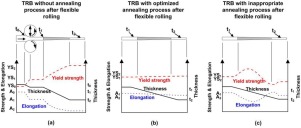当前位置:
X-MOL 学术
›
J. Mater. Process. Tech.
›
论文详情
Our official English website, www.x-mol.net, welcomes your feedback! (Note: you will need to create a separate account there.)
Annealing of HC340LA tailor rolled blanks - control of mechanical properties and formability
Journal of Materials Processing Technology ( IF 6.3 ) Pub Date : 2020-07-01 , DOI: 10.1016/j.jmatprotec.2019.116581 Sijia Zhang , Xianlei Hu , Chunlai Niu , R. Devesh K. Misra , Shu Yan , Xianghua Liu
Journal of Materials Processing Technology ( IF 6.3 ) Pub Date : 2020-07-01 , DOI: 10.1016/j.jmatprotec.2019.116581 Sijia Zhang , Xianlei Hu , Chunlai Niu , R. Devesh K. Misra , Shu Yan , Xianghua Liu

|
Abstract Tailor rolled blanks (TRB) have been extensively used in the automotive industry because of lightweight. Through the flexible rolling process and appropriate annealing treatment, the target geometry, required mechanical properties, and good formability of TRB can be achieved. In this study, two types of annealing processes were attempted, i.e. batch annealing and continuous annealing. The effects of annealing parameters on the microstructure, mechanical properties and formability of HC340LA TRB were investigated. First, a series of batch annealing and continuous annealing were conducted on cold rolled TRB. Next, the microstructure distribution of TRB was evaluated. The mechanical properties and formability of annealed specimens were tested through the uniaxial tensile test and Erichsen cupping test, respectively. The results showed that the mechanical properties and formability were controlled by reduction, annealing type and annealing parameters. During the batch annealing, mechanical properties along the rolling direction were influenced by the degree of recrystallization and the average grain size, the formability increased with the increase of annealing temperature. TRB annealed at 700 °C for 60 min showed relatively homogeneous mechanical properties and good formability in the reduction range of 36–54 %. During continuous annealing, the mechanical properties and formability were determined by the degree of austenitization and the average grain size. TRB annealed at 930–950 °C for 3 min showed homogeneous mechanical properties and good formability for the entire range of reduction.
中文翻译:

HC340LA 定制轧制坯料的退火 - 机械性能和成型性的控制
摘要 定制轧制毛坯(TRB)由于重量轻而被广泛应用于汽车工业。通过柔性轧制工艺和适当的退火处理,可以实现TRB的目标几何形状、所需的机械性能和良好的成型性。在这项研究中,尝试了两种类型的退火工艺,即分批退火和连续退火。研究了退火参数对HC340LA TRB显微组织、力学性能和成形性的影响。首先,对冷轧TRB进行了一系列的间歇退火和连续退火。接下来,评估TRB的微观结构分布。退火试样的力学性能和成形性分别通过单轴拉伸试验和埃里克森杯突试验进行测试。结果表明,力学性能和成形性受还原性、退火类型和退火参数的控制。分批退火过程中,轧制方向的力学性能受再结晶程度和平均晶粒尺寸的影响,成形性随退火温度的升高而提高。在 700°C 下退火 60 分钟的 TRB 显示出相对均匀的机械性能和良好的成型性,在 36-54% 的还原范围内。在连续退火过程中,机械性能和成形性由奥氏体化程度和平均晶粒尺寸决定。在 930-950°C 下退火 3 分钟的 TRB 在整个还原范围内显示出均匀的机械性能和良好的成型性。退火类型和退火参数。分批退火过程中,轧制方向的力学性能受再结晶程度和平均晶粒尺寸的影响,成形性随退火温度的升高而提高。在 700 °C 下退火 60 分钟的 TRB 显示出相对均匀的机械性能和良好的成型性,在 36-54% 的还原范围内。在连续退火过程中,机械性能和成形性由奥氏体化程度和平均晶粒尺寸决定。在 930-950°C 下退火 3 分钟的 TRB 在整个还原范围内显示出均匀的机械性能和良好的成型性。退火类型和退火参数。分批退火过程中,轧制方向的力学性能受再结晶程度和平均晶粒尺寸的影响,成形性随退火温度的升高而提高。在 700°C 下退火 60 分钟的 TRB 显示出相对均匀的机械性能和良好的成型性,在 36-54% 的还原范围内。在连续退火过程中,机械性能和成形性由奥氏体化程度和平均晶粒尺寸决定。在 930-950°C 下退火 3 分钟的 TRB 在整个还原范围内显示出均匀的机械性能和良好的成型性。沿轧制方向的力学性能受再结晶程度和平均晶粒尺寸的影响,成形性随退火温度的升高而提高。在 700°C 下退火 60 分钟的 TRB 显示出相对均匀的机械性能和良好的成型性,在 36-54% 的还原范围内。在连续退火过程中,机械性能和成形性由奥氏体化程度和平均晶粒尺寸决定。在 930-950°C 下退火 3 分钟的 TRB 在整个还原范围内显示出均匀的机械性能和良好的成型性。沿轧制方向的力学性能受再结晶程度和平均晶粒尺寸的影响,成形性随退火温度的升高而提高。在 700°C 下退火 60 分钟的 TRB 显示出相对均匀的机械性能和良好的成型性,在 36-54% 的还原范围内。在连续退火过程中,机械性能和成形性由奥氏体化程度和平均晶粒尺寸决定。在 930-950°C 下退火 3 分钟的 TRB 在整个还原范围内显示出均匀的机械性能和良好的成型性。在 700°C 下退火 60 分钟的 TRB 显示出相对均匀的机械性能和良好的成型性,在 36-54% 的还原范围内。在连续退火过程中,机械性能和成形性由奥氏体化程度和平均晶粒尺寸决定。在 930-950°C 下退火 3 分钟的 TRB 在整个还原范围内显示出均匀的机械性能和良好的成型性。在 700°C 下退火 60 分钟的 TRB 显示出相对均匀的机械性能和良好的成型性,在 36-54% 的还原范围内。在连续退火过程中,机械性能和成形性由奥氏体化程度和平均晶粒尺寸决定。在 930-950°C 下退火 3 分钟的 TRB 在整个还原范围内显示出均匀的机械性能和良好的成型性。
更新日期:2020-07-01
中文翻译:

HC340LA 定制轧制坯料的退火 - 机械性能和成型性的控制
摘要 定制轧制毛坯(TRB)由于重量轻而被广泛应用于汽车工业。通过柔性轧制工艺和适当的退火处理,可以实现TRB的目标几何形状、所需的机械性能和良好的成型性。在这项研究中,尝试了两种类型的退火工艺,即分批退火和连续退火。研究了退火参数对HC340LA TRB显微组织、力学性能和成形性的影响。首先,对冷轧TRB进行了一系列的间歇退火和连续退火。接下来,评估TRB的微观结构分布。退火试样的力学性能和成形性分别通过单轴拉伸试验和埃里克森杯突试验进行测试。结果表明,力学性能和成形性受还原性、退火类型和退火参数的控制。分批退火过程中,轧制方向的力学性能受再结晶程度和平均晶粒尺寸的影响,成形性随退火温度的升高而提高。在 700°C 下退火 60 分钟的 TRB 显示出相对均匀的机械性能和良好的成型性,在 36-54% 的还原范围内。在连续退火过程中,机械性能和成形性由奥氏体化程度和平均晶粒尺寸决定。在 930-950°C 下退火 3 分钟的 TRB 在整个还原范围内显示出均匀的机械性能和良好的成型性。退火类型和退火参数。分批退火过程中,轧制方向的力学性能受再结晶程度和平均晶粒尺寸的影响,成形性随退火温度的升高而提高。在 700 °C 下退火 60 分钟的 TRB 显示出相对均匀的机械性能和良好的成型性,在 36-54% 的还原范围内。在连续退火过程中,机械性能和成形性由奥氏体化程度和平均晶粒尺寸决定。在 930-950°C 下退火 3 分钟的 TRB 在整个还原范围内显示出均匀的机械性能和良好的成型性。退火类型和退火参数。分批退火过程中,轧制方向的力学性能受再结晶程度和平均晶粒尺寸的影响,成形性随退火温度的升高而提高。在 700°C 下退火 60 分钟的 TRB 显示出相对均匀的机械性能和良好的成型性,在 36-54% 的还原范围内。在连续退火过程中,机械性能和成形性由奥氏体化程度和平均晶粒尺寸决定。在 930-950°C 下退火 3 分钟的 TRB 在整个还原范围内显示出均匀的机械性能和良好的成型性。沿轧制方向的力学性能受再结晶程度和平均晶粒尺寸的影响,成形性随退火温度的升高而提高。在 700°C 下退火 60 分钟的 TRB 显示出相对均匀的机械性能和良好的成型性,在 36-54% 的还原范围内。在连续退火过程中,机械性能和成形性由奥氏体化程度和平均晶粒尺寸决定。在 930-950°C 下退火 3 分钟的 TRB 在整个还原范围内显示出均匀的机械性能和良好的成型性。沿轧制方向的力学性能受再结晶程度和平均晶粒尺寸的影响,成形性随退火温度的升高而提高。在 700°C 下退火 60 分钟的 TRB 显示出相对均匀的机械性能和良好的成型性,在 36-54% 的还原范围内。在连续退火过程中,机械性能和成形性由奥氏体化程度和平均晶粒尺寸决定。在 930-950°C 下退火 3 分钟的 TRB 在整个还原范围内显示出均匀的机械性能和良好的成型性。在 700°C 下退火 60 分钟的 TRB 显示出相对均匀的机械性能和良好的成型性,在 36-54% 的还原范围内。在连续退火过程中,机械性能和成形性由奥氏体化程度和平均晶粒尺寸决定。在 930-950°C 下退火 3 分钟的 TRB 在整个还原范围内显示出均匀的机械性能和良好的成型性。在 700°C 下退火 60 分钟的 TRB 显示出相对均匀的机械性能和良好的成型性,在 36-54% 的还原范围内。在连续退火过程中,机械性能和成形性由奥氏体化程度和平均晶粒尺寸决定。在 930-950°C 下退火 3 分钟的 TRB 在整个还原范围内显示出均匀的机械性能和良好的成型性。


























 京公网安备 11010802027423号
京公网安备 11010802027423号